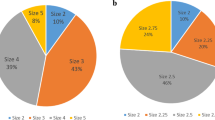Abstract
The intravaginal slingplasty procedure (IVS) was carried out on 75 patients with genuine stress urinary incontinence. The main aims of the operation are to create an artificial pubourethral ligament and to tighten the suburethral vaginal wall. An important ingredient in the supportive structures of the genitourinary region is fibrous connective tissue, consisting mainly of collagen. To analyse thi component biopsies were obtained transvaginally, close to the position of the sling, both preoperatively and 2 years after surgery, from 6 patients. Collagen was analysed for concentration and extractability. Extractability by pepsin digestion was increased by 60% 2 years following surgery. Postoperative follow-up studies from 12 months to 3 years showed complete restoration of continence in 63 patients (84%) and considerable improvement in 4 others (5%). The 8 failures (9%) were all related to early rejection of the sling. The IVS procedure is an attractive surgical procedure as it necessitates minimum invasion and can be performed under local anesthesia, with a short hospital stay and sick-leave period. The enhanced collagen extractability indicates a changed metabolism, most likely induced by the implanted sling, resulting in a restoration of the elastic properties of the connective tissue.
Similar content being viewed by others
References
Hilton P. Which operation and for which patient? In: Drife JO, Hilton P, Stanton SL (eds.) Micturition. London: Springer Verlag, 1990
Abrams P, Blaivas J, Stanton S, Andersen J. The standardization of terminology of lower urinary tract function recommended by the International Continence Society.Int Urogynecol J 1990; 1:45–58
DeLancey JOL. Structural support of the urethra as it relates to stress urinary incontinence: the hammock hypothesis.Am J Obstet Gynecol 1994;170:1713–1723
Versi E, Cardozo L, Brincat M, Cooper D, Montgomery J. Correlation of urethral physiology and skin collagen in postmenopausal women.Br J Obstet Gynaecol 1988;95:147–152
Bergman A, Elia G, Cheung D, Perelman N, Nimni M. Biochemical composition of collagen in continent and stress urinary incontinent women.Gynecol Obstet Invest 1994;37:48–51
Petros P, Ulmsten U. An integral theory and its method for the diagnosis and management of female urinary incontinence.Scand J Urol Nephrol 1993;Suppl 153:5–52
Ulmsten U, Petros P. Intravaginal sling plasty (IVS): an ambulatory surgical procedure for treatment of female urinary incontinence.Scand J Urol Nephrol 1995;29:75–82
Victor A. Pad weighing test—a simple method to quantitate urinary incontinence.Ann Med 1990;22:443–447
Ulmsten U, Asmussen M, Lindström K. A new technique for simultaneous urethrocystometry and measurement of urethral pressure profile. Urol Int 1977;32:127–136
Uldbjerg N, Ekman G, Malmström A, Olsson K, Ulmsten U. Ripening of the human uterine cervix related to changes in collagen, glycosaminoglycans, and collagenolytic activity.Am J Obstet Gynecol 1983;147:662–666
Stegeman H, Stalder K. Determination of hydroxyproline.Clin Chem Acta 1967;18:267–273
Yamauchi M, Woodley DT, Mechanic GL. Aging and crosslinking of skin collagen.Biochem Biophys Res Commun 1988; 152:898–903
Hayflick L. Theories of biological aging.Exp Geront 1985; 20:145–149
Falconer C, Ekman-Ordeberg G, Ulmsten U, Westergren-Thorsson G, Barchan K, Malmström A. Changes in paraurethral connective tissue at menopause or counteracted by estrogen.Maturitas 1996, (in press)
Westby M, Asmussen M, Ulmsten U. Location of maximum intraurethral pressure related to urogenital diaphragm in the female subject studied by simultaneous urethrocystometry and voiding urethrocystography.Am J Obstet Gynecol 1982;144:408–412
Keane DP, Eckford DE, Abrams P. Surgical treatment and complications of urinary incontinence.Curr Opin Obstet Gynecol 1992;4:559–564
Ulmsten U, Henriksson L, Johnsson P, Varhos G. An ambulatory surgical procedure under local anaesthesia for treatment of female urinary incontinence. Int Urogynecol J 1996, (in press)
Author information
Authors and Affiliations
Additional information
Editorial comment: This paper addresses two aspects of the newly described minimally invasive ‘slingplasty’ procedure for stress incontinence: the success of the procedure and its effect on collagen metabolism in the area of the surgery. With a reported success rate of 89%, the slingplasty compares favorably to other incontinence procedures. Unfortunately, postoperative urodynamic evaluation with repeat cystometrogram and urethral pressure profilometry was not performed; the success of the procedure was evaluated by standardized questionnaire, subjective grading of leakage on a visual analogue scale, 48-hour urolog, 24-hour pad test and cough stress test with a full bladder. Multichannel studies would be of interest to clarify the effect of the slingplasty and proposed change in collagen metabolism on urethral pressure measurements. It would also be interesting to visualize the anatomic and functional results of the surgery by either ultrasound, voiding cystometrogram or videourodynamics. The other goal of the study was to assess the effect of the procedure on collagen in the periurethral area. Although the finding of increased collagen turnover is thought-provoking, the lack of samples obtained and the confounding effect of a simultaneously performed anterior repair limits the conclusions that can be made.
Rights and permissions
About this article
Cite this article
Falconer, C., Ekman-Ordeberg, G., Malmström, A. et al. Clinical outcome and changes in connective tissue metabolism after intravaginal slingplasty in stress incontinent women. Int Urogynecol J 7, 133–137 (1996). https://doi.org/10.1007/BF01894201
Issue Date:
DOI: https://doi.org/10.1007/BF01894201




